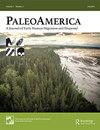Depositional Contexts and New Age Controls for Terminal-Pleistocene Megafauna in North-central Chile (31°50′S)
IF 1.7
Q1 ANTHROPOLOGY
引用次数: 4
Abstract
ABSTRACT Sites in north-central Chile have yielded late-Pleistocene megafauna bone remains, occasionally associated with human-made artifacts. However, little is known about the depositional characteristics, the conditions that allow their preservation, and how to identify recurrences facilitating their discovery. This work presents contextual and stratigraphic data, coupled with radiocarbon dates on bone material from surface findings and excavations conducted in Los Vilos (Coquimbo, Chile), which show that this area was rich in Pleistocene terrestrial mammals and that alluvial sequences and dunes have allowed bone preservation and exposure. These results have implications for the search for new evidence and for the interpretation of their historical trajectories. Radiometric age distribution indicates mainly terminal-Pleistocene specimens with the potential of some taxa persisting into the Holocene. These results are used to discuss coexistence and interaction scenarios between extinct faunas and the early record of human beings in the region.智利中北部(31°50′S)晚更新世巨型动物群的沉积背景和新时代控制
智利中北部的遗址发现了晚更新世巨型动物的骨骼遗骸,偶尔与人造文物有关。然而,人们对其沉积特征、保存条件以及如何识别复现以促进其发现知之甚少。这项工作提供了背景和地层数据,加上在Los Vilos (Coquimbo, Chile)进行的地表发现和挖掘的骨骼材料的放射性碳年代,表明该地区富含更新世陆生哺乳动物,冲积层序和沙丘允许骨骼保存和暴露。这些结果对寻找新的证据和解释它们的历史轨迹具有启示意义。辐射年龄分布显示主要是晚期更新世标本,有些类群可能持续到全新世。这些结果被用来讨论该地区灭绝动物群与人类早期记录之间的共存和相互作用情景。
本文章由计算机程序翻译,如有差异,请以英文原文为准。
求助全文
约1分钟内获得全文
求助全文
来源期刊

PaleoAmerica
Earth and Planetary Sciences-Paleontology
CiteScore
3.70
自引率
0.00%
发文量
15
期刊介绍:
PaleoAmerica disseminates new research results and ideas about early human dispersal and migrations, with a particular focus on the Americas. It fosters an interdisciplinary dialog between archaeologists, geneticists and other scientists investigating the dispersal of modern humans during the late Pleistocene. The journal has three goals: First and foremost, the journal is a vehicle for the presentation of new research results. Second, it includes editorials on special topics written by leaders in the field. Third, the journal solicits essays covering current debates in the field, the state of research in relevant disciplines, and summaries of new research findings in a particular region, for example Beringia, the Eastern Seaboard or the Southern Cone of South America. Although the journal’s focus is the peopling of the Americas, editorials and research essays also highlight the investigation of early human colonization of empty lands in other areas of the world. As techniques are developing so rapidly, work in other regions can be very relevant to the Americas, so the journal will publish research relating to other regions which has relevance to research on the Americas.
 求助内容:
求助内容: 应助结果提醒方式:
应助结果提醒方式:


